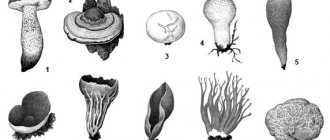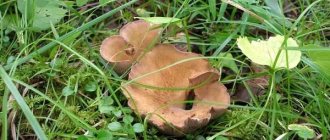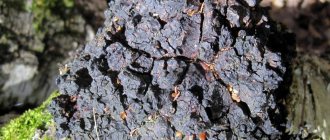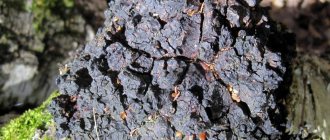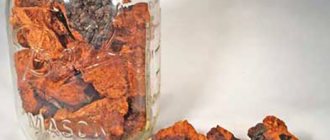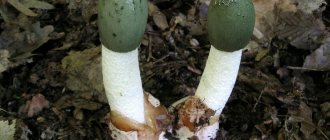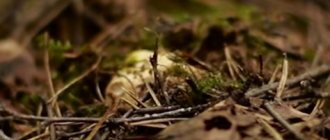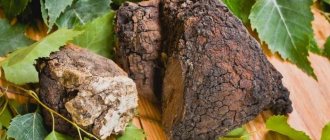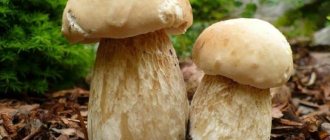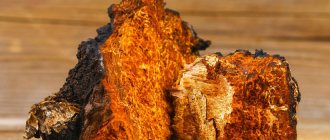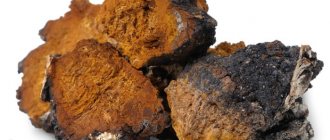Boletus mushrooms are very beautiful in appearance. These aromatic, tasty and satisfying mushrooms are collected in a basket next to plantings of birch, hornbeam and poplar. Mycelium mushrooms grow in damp lowlands and on the edges. From a distance, people notice the portly caps of mushrooms peeking out from under fallen leaves and grass.
The boletus forms a mycorrhizal association with birch trees, as evidenced by the name of the fungus. It is found in Europe, the Himalayas, Asia and other regions of the Northern Hemisphere. Some subspecies have chosen pine or beech forests and the edges of wetlands.
Boletus is a European species. But it has been introduced with ornamental birch trees planted outside their native range, such as in California, New Zealand and Australia.
Description
At first the cap is hemispherical, its diameter is 5–15 cm. Over time it flattens. The cover of the cap is gray-light brown or gray-reddish brown, later losing shades, becoming brown, smooth, hairless, dry and rather slimy in humid conditions.
In young specimens the pores are white, later turning gray. In older boletuses, the pores on the villi protrude, and the stems around them are strongly pressed in. The pore coating is easily removed from the mushroom cap.
The stalk is thin and tapers upward, 5–15 cm long and 1–3.5 cm wide, covered with scales. They are white, dark to black. The main mycelium is white. The pulp is whitish, later gray-white, and retains its color when broken.
In young individuals, the body flesh of the fungus is relatively dense, but very soon becomes spongy, loose and retains water, especially in humid conditions. Turns black after cooking.
The process of dispute formation
The formation of spores in all fungi occurs in the same way. The name of these microscopic particles translated means “seeds”. Scientists suggest that this method of reproduction of organisms appeared more than 400 million years ago. This method of reproduction helped living organisms conserve energy to live in unfavorable conditions. Today, organisms that have the ability to reproduce by spores are considered the most viable.
Mold is considered the most viable today. Some of its types are dangerous to human health, have a negative effect on the lungs and skin, and some are used to make medicines and culinary dishes. In people with allergies, mold fungi, once the spores mature, cause a runny nose, sneezing and itching.
Inside the fruiting body there are special cells called sporangia. Fungal spores form inside them. Cells intended for reproduction can form on aerial mycelium. They are called conidia. Under a microscope, it appears that the aerial mycelium consists of branches, at the ends of which microscopic reproductive cells are located. Cells formed in sporangia are called sporangiospores (endogenous spores), while the latter are called conidia. Some of the microscopic cells are motile, some are not equipped with flagella that allow them to move.
The structure of fungal spores is quite simple. For many representatives of the mushroom kingdom it differs slightly.
Spores of any fungi germinate only in a suitable environment. When exposed to an unfavorable environment, they die. The spores contain a small amount of nutrients, which does not allow them to remain viable for a long period of time. The only exception is conidia. They are able to remain viable for a long period of time. However, their formation takes much longer than the formation of sporangiospores.
Irina Selyutina (Biologist):
Based on their structural features, mushrooms are divided into:
- lower: these include fungi with a unicellular mycelium, and in the most primitive ones, the vegetative body is represented by a bare protoplast (mukor, etc.);
- higher: characterized by the presence of multicellular mycelium (ascomycetes, basidiomycetes).
Asexual reproduction of many lower fungi occurs with the help of motile zoospores, which are formed in zoosporangia. In other fungi belonging to this group, spores that lack organs of movement are formed in sporangia and are called sporangiospores. Sporangia are placed on special hyphae, different from the rest - sporangiocares, which rise to the top from the substrate on which the fungus develops. This arrangement of sporangia relative to the surface is very convenient in terms of the spread of spores by air currents.
Asexual reproduction with the help of conidia or conidiospores is characteristic of marsupials, basidial fungi, imperfect fungi, and a small number of species of lower fungi that have adapted to a terrestrial lifestyle. Coated conidia can be airborne over long distances. There is information that spores of the causative agent of wheat stem rust were discovered at a distance of 1000 km from the place of their mass development. In ascomycetes, conidia are formed on special outgrowths of the mycelium - conidiophores.
Mushrooms have different spores. Their surface may be dry or slimy. Over the long period of existence of fungi on our planet, these microscopic cells have learned to adapt to environmental conditions.
The diameter of the reproductive fungal cell varies from 1 to 100 microns.
Types of edible boletus
Marsh boletus
hat
The fruiting bodies are decorated with convex caps up to 10 cm in diameter with a narrow strip of “tissue” surrounding the edge. Often pure white, especially on young fruiting bodies, the caps sometimes acquire a brownish, gray, or pink tint, darkening and turning green with age.
The surface is initially covered with fine hairs, but later becomes smooth, with a sticky texture with age or humid conditions. The pulp is white and has no distinct odor or taste.
There is a slight color reaction when broken. On the underside there is a porous surface containing 2 to 3 pores per mm. Pore tubes up to 2.5 cm deep. The color of the pores ranges from whitish to grayish, dirty brown.
Leg
The whitish surface of the stalk is strewn with small, hard, protruding scales that darken with age. The length of the leg is 8–14 cm, width – 1–2 cm. The base of the leg is often painted bluish.
Edibility
The mushroom is considered edible, although opinions on its culinary appeal vary. Harvest before the pulp becomes spongy and the arthropods lay larvae. The mushroom is soft, somewhat sweet in taste, it intensifies after a short cooking. Dehydration improves flavor but reduces sweetness.
Common boletus
Stem
A whitish or bright red leg 7-20 cm high, 2-3 cm in diameter. Dark brown scales cover the entire surface, but are noticeably coarser at the bottom. Immature specimens rest on barrel-shaped legs. Mature specimens have stems of a more regular diameter, slightly tapering towards the apex.
hat
The caps show different shades of brown, sometimes with a red or gray coating (there are also white caps), ranging from 5 to 15 cm in diameter when fully expanded, often deformed, with wavy edges. The surface is initially fine-grained (feels like velvet), but smoothes out with aging.
Stem pulp
The body is white or slightly pink when cut or broken, but does not turn blue - useful for identification. The mushroom has a pleasant smell and taste, but they are not very pronounced.
Boletus is harsh
Leg
Dimensions 8-20 × 2-4 cm, hard, thin, subcylindrical, strong, increases in the center and decreases at the base and apex. The color is dirty whitish, bluish-green near the ground. Initially decorated with light gray scales, they soon change color to brown or grey-blackish. The longitudinal squamules at the top of the stem form a dark and raised ridge.
hat
Gray-beige, gray-brown, rarely pale, often predominately ocher, 6-18 cm across. The cap is a hemisphere at first, then it is convex-spherical, flat at the thermal stage of life. The smooth, velvety cuticle cracks in dry conditions.
Compact, hard flesh in young specimens, soft in mature specimens, fibrous in the stem. Whitish in cross section quickly becomes pale pink, then blackish-gray. At the base of the leg, bluish-green spots appear in cross-section. The smell is slight, with a slight sweet taste.
Edibility and toxicity
Considered good once cooked, except for the stem, which is discarded due to being fibrous and leathery.
Boletus variegated
It has a characteristic spotted cap 5-15 cm in diameter when fully expanded. Appearing in mossy forests under birch trees or on wet heaths, the color varies from almost white to medium brown and even black.
The hat is decorated with variegated/speckled radial patterns of lighter spots/stripes. The texture is rough or finely scaly in young mushrooms. It smooths out with aging. The whitish flesh turns pink under the cuticle when broken or cut. Near the base of the stem, the cut flesh turns green and blue.
Stem
White or bright scarlet, height 7-15 cm, 2-3 cm in diameter, tapering towards the apex. Immature specimens with barrel-shaped stems; at maturity more regular in diameter, but slightly tapering towards the apex. The scales on the stalk are black or dark brown. The taste of the multi-colored boletus is naturally mushroom-like, without a pronounced aroma.
Pink boletus
hat
3-20 cm in diameter, dry and smooth or slightly rough, fleshy and strong. In young specimens it is shaped like a semi-spherical shape. With age, it takes on the appearance of a pillow, the edges are blunt, slightly wavy. In humid conditions the cap feels a little slimy to the touch.
Stem
The shape is cylindrical. The pulp is dense, white in color. The height of the leg is 15-20 cm, diameter is 1-4 cm, it thickens slightly near the ground. Externally fibrous, grayish or brownish with a characteristic pattern of black or brown scales.
Pulp
After the rain it loosens and falls apart. The color is yellowish, whitish or grayish, quickly absorbs moisture. During mechanical action, the color is preserved.
Gray boletus
hat
Uneven, wrinkled, up to 14 cm in diameter, shade from olive-brown to brownish-gray. In immature specimens the shape is hemispherical, in ripe mushrooms it resembles a pillow. The flesh is soft and loses tenderness with age. The cut is pinkish, then gray and black. The pleasant smell and taste remains.
Stem
Cylindrical in shape, scales on the surface, 5-13 cm in height, up to 4 cm in diameter, grayish, slightly brown below.
Black boletus
hat
5–15 cm in diameter, blunt edges. The surface is smooth, bare, not wet, dark brown or black; in young specimens it is a hemisphere, then convex, then convex-flat.
Leg
Barrel-shaped, 5–20 cm in length, 2–3 cm in diameter. It is slightly thickened at the base, the color is gray or grayish, covered with small black scales. The cap flesh is pleasant to the taste and aromatic, fleshy. Loses tenderness with age.
What does Chaga look like? What does the Chaga mushroom look like, places of distribution, photo
In the vast mushroom kingdom there are special species that, despite being inedible, are collected and even propagated. These include the chaga fungus, which parasitizes birch trees. It is actively harvested as a medicine.
Chaga (Inonotus obliquus), also known as black birch fungus or tinder fungus, belongs to the Hymenocheteaceae family of the Agaricomycetes class. Its life cycle reaches 20 years, and the birch tree on which the fungus settles inevitably dies. Pay special attention to what chaga looks like in the photo below.
- Outwardly, it is a black, cracked growth of irregular shape on the surface, tending to be round. It is deeply embedded in the wood;
- The pulp is hard and woody. The deep layer is dark brown, close to the trunk is lighter, reddish-brown;
- hyphae are colorless. Their light veins densely penetrate the flesh at the base;
- has the following characteristics: dimensions – up to 50 cm in diameter, thickness – up to 20 cm, weight – up to 2 kg.
At this stage of development, the chaga mushroom has renowned medicinal properties.
Education
Birch chaga penetrates into wood through cracks in the bark damaged by the sun, frost, and insects, and only colonizes fairly mature trees. Having settled inside, the spores germinate and develop within 4 years. Then a characteristic dark growth appears on the surface of the trunk, which grows for a long time, increasing in size. Hyphae penetrate 0.5-1 m deep into the wood, depriving the tree of nutrition.
This parasitic tinder fungus also grows on aspen, linden, alder, rowan, beech, elm, and maple, but only the birch chaga mushroom has medicinal properties.
Where, when and how to collect?
The areas of distribution of chaga coincide with the growth area of birches - the forest spaces of the Russian central zone, especially its northern regions, and the taiga. Black birch mushroom can be found in Eastern European and Korean forests, as well as the northern United States.
It is most convenient to harvest chaga in the forest when dense foliage does not interfere with looking for growths on the birch - that is, in early spring, winter and late autumn. Only mushrooms from living trees that have not yet fallen are suitable for collection. Chaga is also not collected from the lowest, root parts of old birch trees.
The woody body of the mushroom is cut off with an ax at the base, which is firmly embedded in the trunk. Lighter, loose internal areas are cleaned off, and remnants of wood and bark are also removed. The remaining dark, dense part of the mushroom is cut into pieces 3-6 cm in size and dried in air or in the oven at a temperature not exceeding 60 ºС.
Chemical composition
The valuable medicinal properties of chaga are determined by the complex set of chemical compounds it contains. This mushroom is rich in polysaccharides and specific organic acids, pteric and steroid compounds, alkaloids, resins and pigments, macro- and microelements, including an unusually large amount of manganese.
The most intense healing effect is exerted by the chromogenic polyphenylcarbonate complex, which, according to research, is a unique and powerful biogenic stimulant. This complex compound, at the same time, determines the dark brown color of the medicinal mushroom. Therefore, only dark-colored parts of the hard, woody pulp are reasonably selected for harvesting.
Chaga is a potent, biologically active remedy. Before using black birch mushroom preparations, consultation with a specialist is necessary.
Areas of use
Medicines prepared from dried chaga help with:
- Gastritis with insufficient secretion of gastric juice.
- Ulcers of the duodenum and stomach.
- Polyposis of the digestive tract.
- Oncological diseases, especially affecting organs with abundant blood supply - lungs, stomach, as well as in cases that exclude radiation therapy and surgical methods. At the same time, the development of tumors in the initial stages is stopped.
- Diabetes mellitus.
- Decreased immunity.
Chaga is taken in the form of infusion, dried Biochaga extract and the drug Befungin.
The inedible tinder fungus, the destroyer of birches, is, nevertheless, an object of mushroom fishing. Preparations made from black birch chaga help with severe and painful illnesses, and promote healing in the early stages of diseases.
False boletus
Death cap
Mushroom hunters without experience collect poisonous toadstool under aspen, birch, and beech trees (as well as boletus), and confuse it with the marsh subspecies. But this poisonous mushroom has no antidote.
The cap of a young grebe is up to 10 cm in diameter, spherical, flattens and shines with age. The surface is light, sometimes greenish or olive. Under the cap there is a specific cuff. The slender stem without scales is widened at the bottom and located in a kind of capsule.
The pulp exudes a pleasant mushroom aroma, fragile, white, sweet. It is distinguished by a hymenophore on the lower part of the cap. The whitish wide plates are clearly visible from below. In this way, the toadstool is not similar to the tubular boletus mushroom.
Bile mushroom
People do not eat it; the gall fungus is bitter and pungent in taste. Conditionally poisonous, it looks like a pink boletus.
hat
The shape is a shiny hemisphere, does not exceed 15 cm in diameter. The surface is brownish or light chestnut.
Stem
There is a dark mesh pattern on the stem near the cap; it is thickened in the middle.
When broken, the bitter, whitish body turns pink, which is what the false mushroom imitates the pink boletus. Regardless of the exposure, the tubes of the false mushroom do not lose their bright pink hue. The difference is that in the edible species the layer of tubes is creamy and turns pink at the break.
Growing at home
You can grow mushroom noodles in your own garden plot or even at home. True, for these purposes you definitely need to buy a special substrate. Most of it consists of sawdust from trees, as well as a large number of herbal additives. Look at the composition. It should contain 80% sawdust from any tree, preferably beech or oak, and 20% cornmeal.
You will need to purchase old sterile mushroom mycelium. It is advisable that it be grown in laboratory conditions.
If you don’t find it on sale, you can always order it on specialized websites.
- So, the substrate prepared in advance needs to be poured with boiling water. You need to pour it thoroughly. Wait for it to cool down. Such heat treatment is a necessary measure in order to disinfect the substrate.
- Next, squeeze out the sawdust well with your hands and then mix it with the mycelium. Approximately one package of mycelium will require about 40 kg of adversary.
- The entire mass must be placed in plastic bags. They are well pressed and tied.
- Several cuts are made on the surface of the cellophane to allow air exchange.
Place the bags in a shady part of the street. If possible, hang the polyethylene above the ground.
For the first 3-4 weeks, try to protect your pleasures from direct sunlight. And after 2 weeks, the first rudiments of future fruiting bodies should appear. Here you can already add diffused lighting.
The fruiting period itself comes in waves. It is believed that the first time you will get practically no harvest, but from the second time there will be a good increase.
Symptoms of poisoning by false boletus
When people eat toadstool, they do not feel anything until the poison penetrates deep into the brain tissue and organs. A person vomits after about 12 hours, suffers from diarrhea, and the body becomes dehydrated. Then a short remission occurs for 2-3 days. On days 3-5 the liver and kidneys fail. If you eat a lot of toadstools, the course of intoxication is more acute and accelerates.
It is almost impossible to get poisoned by gall fungus. Its pungent taste turns off even extreme experimenters. And one gall mushroom, when cooked, will ruin a whole basket of boletus mushrooms; the cook will throw away the dish after trying it. The clinical picture is the same as for any poisoning, but without death.
Preparation
There are no popular common recipes with lion's mane in Russian cuisine. Therefore, let's borrow interesting recipes from other cultures.
Preliminary processing
This mushroom, like many others, needs pre-treatment. It is carried out using the thermal method.
- To do this, place a pan of water and bring to a boil.
- Remove from the mushroom all hanging elements that have become deformed, rotted, or have an unnatural color.
- Next, place the mushroom or mushrooms in boiling water. Leave to simmer for 5 minutes.
- Then, use a slotted spoon to remove the mushrooms and let them cool. They are ready for further use.
Cooking
If you want to cook a mushroom and add it to any dish, then the cooking process should not be interrupted. It should take at least 15-20 minutes depending on the size of the mushroom.
You can also cook chicken fillet with it to get a delicious, aromatic broth.
Subsequently, the chicken fillet can be chopped, add chopped potatoes, carrots and onions. The result is a very tasty mushroom soup, which should be seasoned with sour cream and green onions when serving.
Let's marinate
This mushroom can be pickled for the winter.
To do this you will need:
- approximately 1 kg blackberries.
- garlic 3 cloves.
- 2 tablespoons salt.
- four tablespoons of vinegar.
- a tablespoon of sugar.
- bay leaf, pepper, cloves.
Blackberries must first be prepared by boiling. Then, after cooling, you need to cut it into small pieces.
The blackberries are placed at the bottom of the jar. Pepper, cloves, and bay leaves are also placed there. In a separate vessel, mix salt, vinegar, sugar, and garlic. All this is mixed well, and the mushrooms are poured. If necessary, add water so that there is enough to cover all the mushrooms in the jar. The jars are rolled up with a lid and placed in a cool, dark place. You can eat them after a few weeks.
Freezing
If you do not yet plan to use mushroom noodles for food, but would like to see them fresh in the future, then the most effective method is freezing. Cut the mushrooms into small pieces. Spread evenly on a tray and place in the freezer. Once the pieces are frozen, collect them in a special container or freezer bag. Place in the refrigerator. However, remember that you can store mushrooms in this form for no more than six months.
Let's fry
It is believed that the most delicious serving of such a mushroom is frying it.
Cut the mushroom into small individual pieces. Heat oil in a frying pan.
Cut the onion into half rings and throw into the frying pan. Fry it well, then add the mushrooms. Fry everything together until the onion turns golden. Remove everything from the heat. Press the garlic through a garlic press. Mix everything very well. Ready mushrooms can be served with potatoes, as well as other types of side dishes. They will be a good addition to oven-baked meat.
Salting
Before the pickling process, it is recommended to soak the mushrooms in cold water. You need to lie in a container completely covered with cold water for 6 to 12 hours. After this, the water is replaced, the mushrooms are placed in a pan and boiled.
Next you need to choose the type of salting. It comes hot and cold.
If you choose the cold method, then the mushrooms should be boiled for 15 minutes. Then the water needs to be drained, the mushrooms are washed well under plain water at room temperature and cooled.
Brine is prepared separately for them. To do this, you need to take about 80 g of salt per 1 kg of mushrooms. Then, add cloves, pepper and bay leaf. Add everything to the water and bring to a boil. Then, cool.
The mushrooms are placed in a jar and then filled with brine. Additionally, you can add dill leaves, garlic, and currant leaves.
If you choose the hot method, then the mushrooms need to be washed well and then cut into small plate-like pieces.
Then cook over low heat for about 2 hours.
After this, the water must be drained and the mushrooms rinsed well.
Separately prepare the brine according to the above recipe.
Then, the mushrooms are distributed into jars and filled with liquid. It would be ideal if you also add dill seeds.
Where and when are boletus harvested?
Mushrooms have chosen deciduous forests in the temperate climate zone and choose clearings for mycelium next to birch trees, with which they form mycorrhizae.
Young mushrooms are strong and tight to palpation. They choose open places for growth on the edges, clearings and along paths. The boletus does not like acidified soils near peat bogs; it chooses soil in low-lying forests with a neutral or calcareous substrate. People collect mushrooms from May until the autumn cold and first frosts. One of the subspecies - the marsh boletus - settles on peat bogs near swamps.
Multi-colored boletuses grow in small families or one at a time. Their colorful caps attract mushroom pickers from late June to early October. Mushrooms are cut under birch and poplar trees. Myceliums take root in mossy and gloomy forests, but in open areas under the rays of the sun.
A rare species, the pink boletus settles on peat bogs along the borders of swamps near birch and mixed forests, where it forms mycorrhiza with birch. Mushroom pickers collect mushrooms wherever there are birch plantings, right down to the tundra from the end of July to the end of September.
Gray boletus, also known as hornbeam, produces a rich harvest on the edges and clearings among:
- poplars and birches;
- hazel trees;
- hornbeams and beech trees.
Harvesting:
- when the rowan tree blooms;
- in July after haymaking;
- from late August to October.
Mushroom pickers sometimes find the stiff boletus (rare) in deciduous and deciduous-coniferous plantings near white poplars and aspens. The fungus prefers limestones, where it lives alone or in small families. The rare harvest is harvested from late June to mid-autumn.
In damp lowlands among birches, in pine-birch mixed forests, on the outskirts of clearings and among swamps, from mid-summer until golden autumn, people collect black boletus.
Beneficial features
The mushroom has been studied for a long time, and as a result, scientists have come to the conclusion about the beneficial properties it has.
Medicinal properties
- The mushroom may actually fight Alzheimer's disease.
- It is also an excellent anthelmintic agent.
- Helps lower blood cholesterol levels.
- May inhibit the growth of cancer cells when consumed regularly. Is an immunomodulator.
- Fights sarcoma, stomach cancer.
- Negatively affects the development of staphylococcus.
- Prevents the formation of stomach and duodenal ulcers.
- It has a hypotensive effect and can protect the gastric mucosa from acidic gastric juice.
